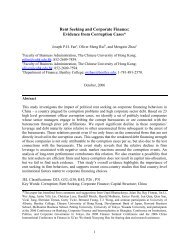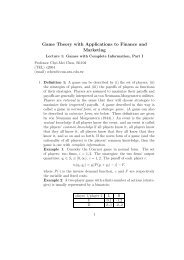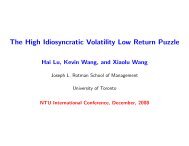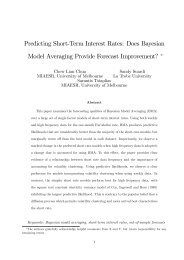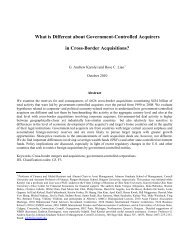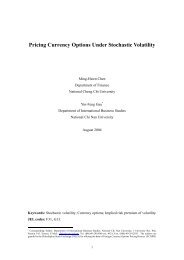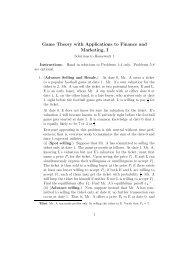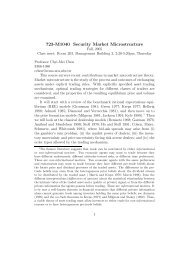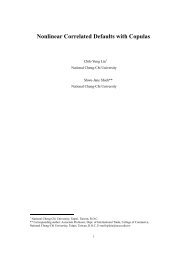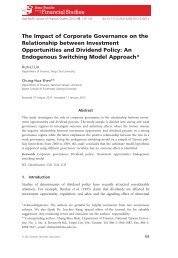Game Theory with Applications to Finance and Marketing
Game Theory with Applications to Finance and Marketing
Game Theory with Applications to Finance and Marketing
Create successful ePaper yourself
Turn your PDF publications into a flip-book with our unique Google optimized e-Paper software.
β he would get 1, <strong>and</strong> <strong>with</strong> probability 1 − β, he would get 4 (which<br />
is the firm value that the s<strong>to</strong>ck market believes upon seeing π 1 = 2).<br />
Hence by deviation Mr. A gets the payoff<br />
β · 1 + (1 − β) · 4 = 13<br />
7 < 2.<br />
Thus Mr. A has no incentive <strong>to</strong> deviate. This proves that exerting a<br />
high effort is indeed Mr. A’s equilibrium behavior. Thus the date-1<br />
share price is, <strong>with</strong> probability one, 4.<br />
Value maximization results in a moral hazard problem in this exercise,<br />
because Mr. A has an incentive <strong>to</strong> manipulate the market’s belief<br />
regarding the unobservable effort. As is common in the moral hazard<br />
literature, the equilibrium effort may be higher or lower than the effort<br />
level chosen by Mr. A when his effort is observable. We have seen<br />
in Example 9 that the managerial effort can be <strong>to</strong>o low in the signaljamming<br />
equilibrium; here, it is <strong>to</strong>o high.<br />
30. Example 11. Two firms compete in an industry that extends for two<br />
dates (t = 1, 2). Firm 2 may be of type G <strong>with</strong> prob. b <strong>and</strong> type B<br />
<strong>with</strong> prob. 1 − b. Neither firm 1 nor firm 2 knows firm 2’s type (notice<br />
that we are abusing terminology here!). The game proceeds as follows.<br />
At t = 1, firm 1 can choose either P (prey) or A (accomodate). If firm<br />
1 chooses P, then firm 1’s profit is −c < 0 <strong>and</strong> firm 2’s profit is L < 0<br />
at date 1. If firm 1 chooses A, then firm 1’s profit is 0 at date 1; firm<br />
2’s profit is H > 0 if its type is G <strong>and</strong> is L < 0 if its type is B. Firm 1’s<br />
action at date 1 is firm 1’s private information. After seeing its date-1<br />
profit, firm 2 must decide whether <strong>to</strong> exit at the beginning of date 2.<br />
If firm 2 decides <strong>to</strong> leave, firm 1 gets M > 0 <strong>and</strong> firm 2 gets zero at<br />
date 2; if firm 2 decides <strong>to</strong> stay, then firm 1 again must decide <strong>to</strong> P or<br />
<strong>to</strong> A at date 2, <strong>and</strong> the payoffs of the two firms at date 2 are just as<br />
described for date 1. Each firm seeks <strong>to</strong> maximize the sum of its profits<br />
at the two dates.<br />
Find conditions on the parameters sustaining the SPNE’s where, respectively,<br />
(1) firm 1 preys at date 1 for sure; (2) firm 1 accomodates<br />
at date 1 for sure; <strong>and</strong> (3) firm 1 r<strong>and</strong>omizes over P <strong>and</strong> A at date 1.<br />
37



